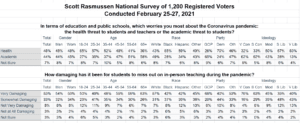Eighty-six percent (86%) of voters believe that missing out on in-person teaching during the pandemic has been damaging to students. A Scott Rasmussen national survey found that just 11% disagree.
Those totals include 53% who believe the impact has been Very Damaging and 3% who say it has not been damaging at all.
This is a rare pandemic-related topic with broad agreement across party lines. Eighty-eight percent (88%) of Republicans believe the lack of in-person teaching has been damaging to students. So do 86% of Independents and 84% of Democrats.
However, the partisan divide appears clearly on a related question. Forty-eight percent (48%) of all voters believe the health threat to students and teachers is greater than the academic threat to students. Forty-four percent (44%) take the opposite view. On this question, 70% of Democrats see the health issues as a bigger concern while 65% of Republicans are more worried about academic issues. Independents are evenly divided.
Data released recently shows that a plurality of voters believe the worst of the pandemic is behind us. Additionally, 50% believe that many cities and states overreacted to the pandemic in ways that did more harm than good.
SIGN UP to receive Scott’s free email newsletter.
CHECK OUT Scott’s latest polls.
Note: Neither Scott Rasmussen, ScottRasmussen.com, nor RMG Research, Inc. have any affiliation with Rasmussen Reports. While Scott Rasmussen founded that firm, he left more than seven years ago and has had no involvement since that time.
Methodology
The survey of 1,200 Registered Voters was conducted by Scott Rasmussen using a mixed mode approach from February 25-27, 2021. Field work for the survey was conducted by RMG Research, Inc. Most respondents were contacted online or via text while 156 were contacted using automated phone polling techniques. Online respondents were selected from a list of Registered Voters and through a process of Random Digital Engagement. Certain quotas were applied, and the sample was lightly weighted by geography, gender, age, race, education, and political party to reasonably reflect the nation’s population of Registered Voters. Other variables were reviewed to ensure that the final sample is representative of that population.



